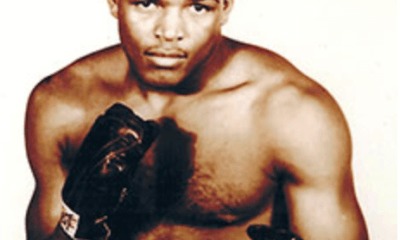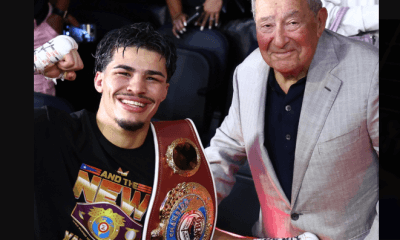Articles of 2006
Ned Carpenter's Great White Hope
The doctor can cure the measles and mumps, The plumber can fix a leak. Druggists’ blue pills cure fever and chills, And rid you of gout in a week. The tailor can hide all your corners and bumps, The shoemaker fixes your soles;
When pebbles and rocks get into your socks There’s someone to fix up the holes. It’s easy to cure most any disease With medicine, hammers or soap; But there’s one thing for sure, For which there’s no cure –– That awful affliction ‘White Hope!’
– Rube L. Goldberg, 1914
One of the best boxing books published in recent years is “The Great White Hopes: The Quest to Defeat Jack Johnson” by British author Graeme Kent. It entertainingly chronicles the frantic and often comical search for a Caucasian boxer good enough to unhorse the first black heavyweight champion of the world, whose supremacy in the ring was an excruciating affront to the sensibilities of white society.
From 1908-1915, writes Kent, White Hopes “rolled off the assembly lines with the regularity of Henry Ford’s new Model Ts, although with less durability.” They were hulking farm boys, ranch hands and factory workers who willingly fed themselves into the boxing grinder to escape the drudgery, anonymity and poverty of their daily lives. For most of them, the rewards were paltry and the punishment harsh. But for a while they were heroes in the small towns that claimed them.
Among those answering the siren call was a Wisconsin baseball player who struck out swinging when he made the switch to the boxing ring.
Born in 1899, Ned Carpenter grew up in Burlington, a small community about 35 miles southwest of Milwaukee. When he was 22, the 6’2”, 200-pound Carpenter was one of the best ballplayers in town. In the spring of 1911, Carpenter auditioned for the Racine team in the Wisconsin-Illinois baseball league. He didn’t make the cut, and returned home that May to pitch the Burlington nine to victory over arch-rival Waterford at Central Park.
But then the worldwide dragnet for White Hopes snared him. The Burlington Standard Democrat announced on October 27, 1911, that Carpenter had left for Chicago to start training for a boxing career.
“Ned has the size, youth and agility to be the ‘white man’s hope,’” said the paper, “and his friends hope some day to see him a winner.”
Their hopes soared when “Carp” returned to Burlington that Thanksgiving looking “fit as a fiddle” thanks to a daily training regimen that included 15 minutes of bag punching, 15 minutes of weight lifting, 15 minutes of shadowboxing and a half hour of rope skipping.
“If plans and aspirations do not miscarry, Burlington is destined to become famous sometime in the future,” reported the front page of the Standard Democrat article on December 8, “through being the hometown of Ned Carpenter, erstwhile baseball player now a candidate for pugilistic honors.”
Six more months passed before Burlington’s White Hope was officially unveiled in the ring. By then there was so much local excitement about him that when Carpenter was matched against a boxer called Young Mahoney in Racine on June 26, 1912, two cars were attached to the 6:48 p.m. train to Racine to accommodate the fans eager to watch their hero take his first giant step toward boxing glory.
Young Mahoney had been around for years and was actually a middleweight who, in 1905, had fought a draw with then-158-pound champion Hugo Kelly. Mahoney was a plumber when he wasn’t fighting, and once, after he’d been stiffed by a customer of Italian ancestry whose toilet he’d unplugged, he announced that he would get his revenge by henceforth fighting and beating only Italian boxers.
Unfortunately for Carpenter, Mahoney no longer drew the ethnic line. Twenty-five pounds lighter than the Burlington fighter, Mahoney knocked him out in the eighth round.
After another six months of retooling, on December 11, 1912 a large crowd at the Burlington Opera House saw Carpenter finally get his boxing career off on the right foot. He knocked out Billy Ryan of Beloit in three rounds, disappointing 400 Ryan boosters who’d come on a special train to cheer for their man.
New York City was boxing’s greatest stage, and with just two fights under his belt that’s where Carpenter headed next. On February 12, 1913, he squared off there against another White Hope named Jim Coffey. A native of Ireland, Coffey was called “The Roscommon Giant,” and it took him just two minutes to stamp out Burlington’s hope.
“Gloom! Gloom!” was the heading over the dispatch in the Standard Democrat reporting Carpenter’s demise.
“The short space of two minutes proved sufficient for Coffey to send the Wisconsin contender into dreamland,” noted the New York Times, “and the ease in which it was accomplished indicated that Coffey might have achieved the same result about two minutes earlier if he had started (then).”
But his manager, H.W. Lawton, put an optimistic spin on it when they returned to Burlington a few days later, telling the Standard Democrat that “the crowd all knew it was nothing but a lucky punch and were with Carpenter even after his knockout in the first round.” Furthermore, he stated, when they challenged Coffey to fight again the very next night, The Roscommon Giant (who was actually an inch shorter than Carpenter) said nothing doing.
Meanwhile, another Wisconsin White Hope had appeared on the scene. According to the announcement in the Milwaukee Journal, 6’0”, 195-pound Art Nelson of Wyeville, a village in the western part of the state, “works every day of his existence on a big tract of timberland, and it is nothing for him to clear off an acre a day. When he feels good he just walks out and pulls up a big tree by the roots, breaks it in two and throws it aside with the ease of a child.”
But even more encouraging was that “when the name of champion Jack Johnson is mentioned the blue eyes of the son of Thor shine with a dangerous light and his big hands clench together, while his massive jaw tightens with an ominous snap that bodes no good for the black gladiator if he ever hooks up with the blond-topped athlete.”
Trouble was, that massive jaw also made one hell of a target. In his first fight, Nelson was KO’d in one round by Bill Brennan.
On April 30, 1915, Wisconsin’s White Hopes collided in the ring. The hundred or so fans who journeyed from Burlington to Racine “had the satisfaction of seeing Carpenter give Nelson as severe a beating as any man in the ring ever received,” reported the Standard Democrat.
But Carpenter lost his next five fights and faded from the scene. When he died in 1939, the newspaper that had once hailed him on its front page as “Burlington’s Favorite Son,” reported it in a couple paragraphs.
In what may be an even bigger affront to its Great White Hope, today Burlington, now home to a Nestle candy bar factory, proudly advertises itself as “Chocolate City, USA.”
-

 Featured Articles2 weeks ago
Featured Articles2 weeks agoResults and Recaps from New York Where Taylor Edged Serrano Once Again
-

 Featured Articles2 weeks ago
Featured Articles2 weeks agoResults and Recaps from NYC where Hamzah Sheeraz was Spectacular
-

 Featured Articles3 weeks ago
Featured Articles3 weeks agoFrom a Sympathetic Figure to a Pariah: The Travails of Julio Cesar Chavez Jr
-

 Featured Articles2 weeks ago
Featured Articles2 weeks agoPhiladelphia Welterweight Gil Turner, a Phenom, Now Rests in an Unmarked Grave
-

 Featured Articles1 week ago
Featured Articles1 week agoManny Pacquiao and Mario Barrios Fight to a Draw; Fundora stops Tim Tszyu
-

 Featured Articles22 hours ago
Featured Articles22 hours agoThe Hauser Report: Zayas-Garcia, Pacquiao, Usyk, and the NYSAC
-

 Featured Articles1 week ago
Featured Articles1 week agoArne’s Almanac: Pacquiao-Barrios Redux
-

 Featured Articles3 weeks ago
Featured Articles3 weeks agoCatterall vs Eubank Ends Prematurely; Catterall Wins a Technical Decision














